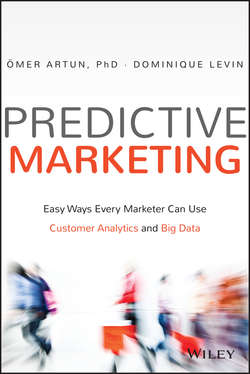Читать книгу Predictive Marketing - Levin Dominique - Страница 10
На сайте Литреса книга снята с продажи.
Part 1
A Complete Predictive Marketing Primer
Chapter 1
Big Data and Predictive Analytics Are Now Easily Accessible to All Marketers
The Predictive Marketing Revolution
ОглавлениеAnticipating customer needs is not a new concept. What is new is the ability to anticipate and respond to customer needs automatically, near real time and at large scale, for hundreds, thousands, or even millions of customers at a time.
Not too long ago, you could walk into a corner store and the salesperson would know your name, know what kind of things you bought, how long you've been a customer, and other important information about your personality and behavior. This relationship not only makes the buying process pleasant, it also increases the likelihood of the customer to return, spend more, and develop a sense of brand loyalty and trust.
These days we shop in supermarkets where nobody knows our name. The promise of predictive marketing is to bring the personal relationships of the corner store to the modern world of online and offline marketing. Using predictive analytics, it is possible to move from an era of mass marketing centered on the products you sell and the promotions you send to an era of highly personalized marketing centered on the customer you serve.
Today, even small- and midsize businesses interact with customers on an enormous scale through a wide variety of channels, including websites, social media, mobile apps, and store visits. Because of the substantial increase in speed, number, and type of customer interactions, companies have a greater opportunity to maintain the kind of personal relationships that used to be an important aspect of doing business. Of course this is not easy, and many companies fail due to lack of technical, organizational capabilities and strategic focus.
Customer interactions and the digitization of so much of our daily activities have allowed businesses to gather an extraordinary amount of data about their customers that can be put to use to better service customers. For example, when you buy a pair of shoes at Zappos, the company knows many things about you: what type of shoes you like, your name, gender, where you live, whether your zip code is mainly made up of apartment buildings or single-family homes, whether you typically buy items at full price or at a discount, whether you bought just one product or multiple products, how often you clicked on a Zappos email or visited its website before placing that first order and what you looked at, how often you called the call center, whether you are a first-time or repeat customer, whether you are a VIP customer or an unprofitable customer who returns more products than she keeps, and much more.
Most companies still find it very difficult to put any of this information to good use. The sheer size and breadth of the records make them incomprehensible for anyone without the training and experience to mine insights from large datasets. This is where predictive analytics and machine learning come in. Machines are very good at mining insights from large datasets automatically. Machines can remember the names of millions of customers with no effort and greet them accordingly, just as the shopkeeper from yesteryear would have done. In other words, using machines, humans can now bring back the personalized marketing interactions from yesteryear, even if their company has millions of customers. Figure 1.1 illustrates how the marketing revolution has come full circle. In the 1800s, shopkeepers had personal relationships with each and every customer. In the 1900s, during the industrial revolution, these personal relationships fell victim to mass marketing and a desire to scale businesses. Now, thanks to the technological revolution, marketers can bring back the personal relationships from yesteryear, while still operating companies at a large scale.
Figure 1.1 The Predictive Marketing Revolution
Predictive marketing is the perfect marriage between machine learning and human intelligence. The point of predictive marketing is not to replace marketers with machines but rather to empower and augment human intelligence with machine learning.
